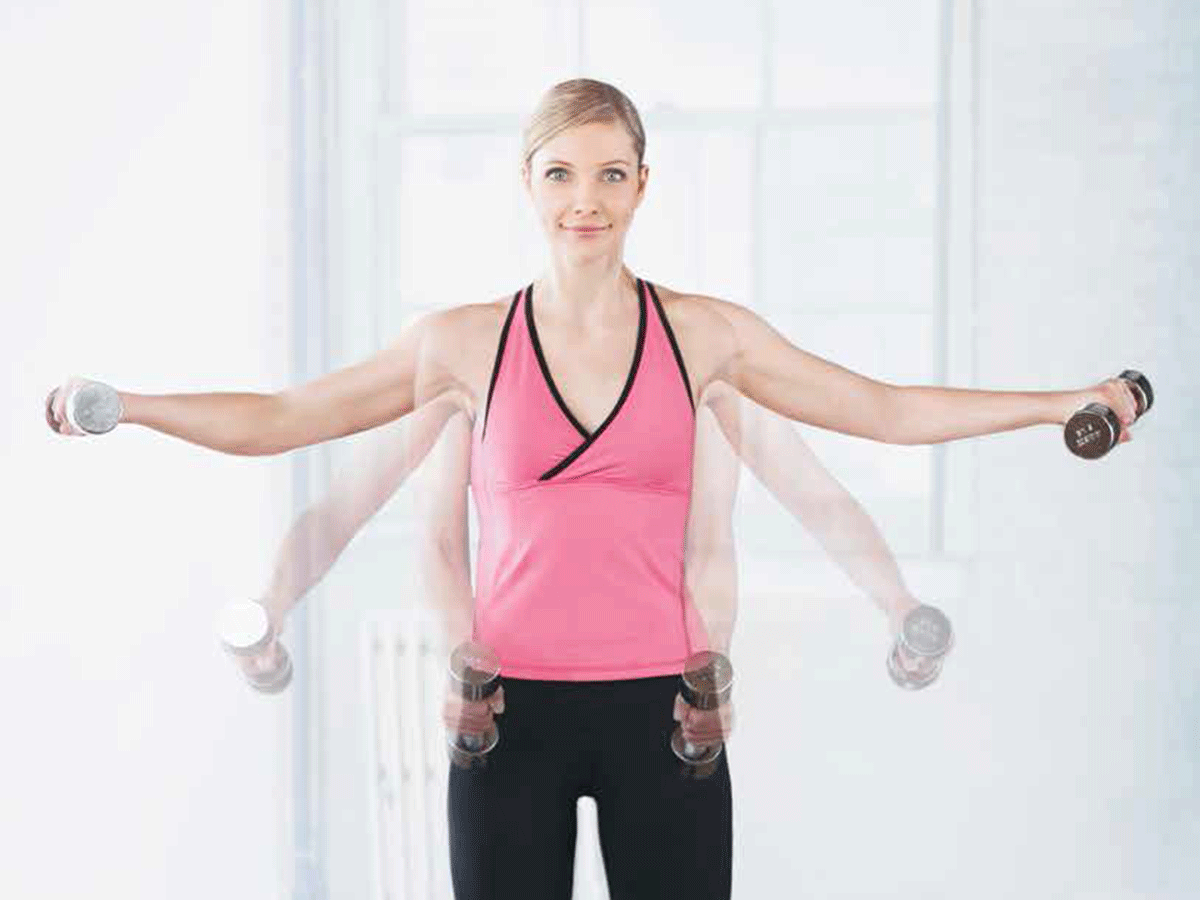
When you’re going sleeveless, nothing says “I’m fit” like nicely toned shoulders.
No matter what the season, strong, balanced shoulder muscles (called deltoids) – along with strong rotator cuff muscles that help to stabilize around the shoulder joint – enable you to move more easily through daily tasks.
Angus Driver, a senior instructor in the orthopaedic division of the Canadian Physiotherapy Association, and a physiotherapist and co-owner at Adelaide West Physiotherapy in Toronto, explains the shoulder socket is shallow: “Think of it like a golf ball sitting on a tee and held in place by ligaments that control motion.” This means the shoulder joint is quite mobile, moving easily in multiple directions, but it’s also more vulnerable to injury, especially from poor exercise technique.
Weak or too-tight ligament don’t always control motion as they should. “Shoulder exercises that take the joint through a range of motion with weights help create better strength and function, and more stability,” says Driver. Shoulder stress during exercise can happen if your form is off or if you are dealing with an underlying problem. “Signs to watch out for include pain in the front of the joint or side of the deltoid,” says Driver, “and any clicking or catching in the joint.” If you’ve got healthy shoulders already, lifting weights help to safeguard them against potential future problems. When you’re armed with confidence about how your upper body can perform, you’ll not only look amazing, but feel stronger, too.
How to get started with your shoulder exercises
Equipment
You’ll need a couple of medium-weight dumbbells (five to eight pounds each), and a light dumbbell (two to three pounds) or a 398 mL can of beans. You’ll also need a small folded-up towel and a mat or large towel to lie on.
Easier option
Stick to the lower range of reps, and do only three of these shoulder exercises – Alternating Front Raise, Back Fly and Side-lying External Rotation – until your shoulders get stronger. You should still use medium dumbbells for these (but a light one for the Side-lying External Rotation).
Warm-up and cool-down
Do a “mock” set of each exercise without the dumbbells to warm up your shoulder joints and the muscles around them, and practise your technique before adding in the weights. Post-workout, take about five minutes to gently stretch your shoulders in different directions. And for a balanced exercise approach, add workouts for your arms, legs, lower back and abs, as well. Once completed, add these six cool-down stretches to your post-workout routine to avoid injury.
How often
Do one set of each exercise for the repetitions suggested. To boost intensity, complete each of the following six shoulder exercises and then do a second round (resting between sets), or do moves using heavier dumbbells. Try this designed-to-do-anywhere plan three times a week on non-consecutive days.
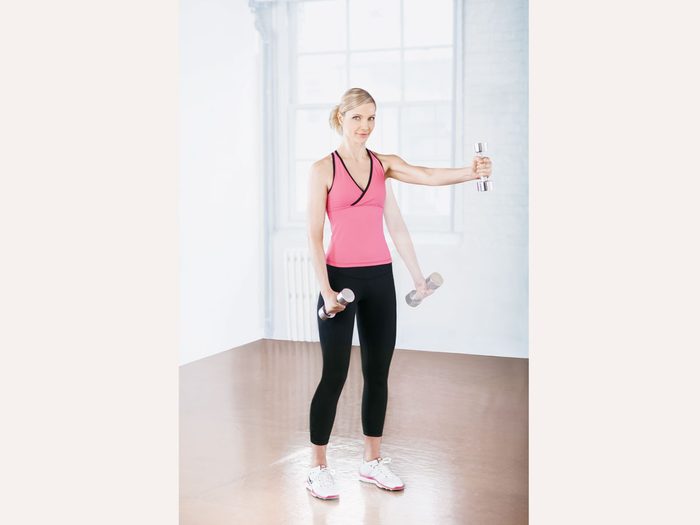
Alternating Front Raise
- Stand with your feet hip-width apart, and a medium dumbbell in each hand. Place your arms by your sides, palms facing inward. Tighten your abs.
- Keep your left arm straight as you raise it to shoulder height.
- As you return your left arm to its starting position, raise your right arm to shoulder height. Continue to alternate between left and right arms. Do eight to 12 reps for each arm.
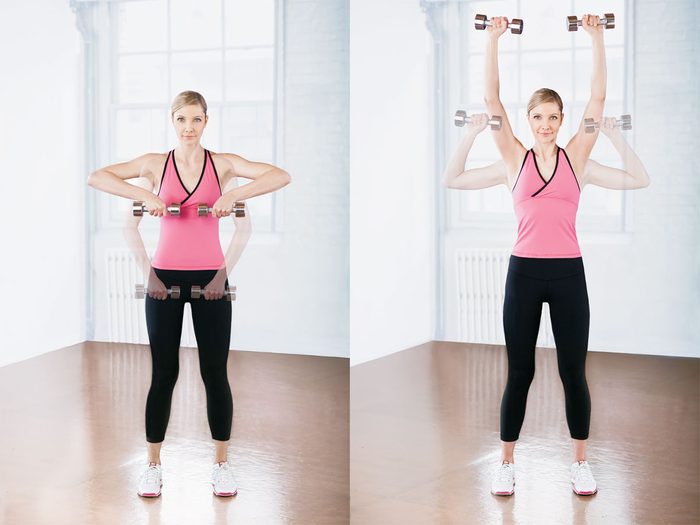
Modified Upright Row to Overhead Arm Press
- Stand with your feet hip-width apart, your knees slightly bent, and a medium dumbbell in each hand. Place your arms down in front of you. Roll your shoulders back and down to keep them from raising up or rounding forward. Move your arms up and along the front of your body while bending arms at the elbows away from your sides as you raise the dumbbells to chest height. Palms should be facing you. Stop when your upper arms are parallel to the floor.
- From there, flip your arms and the dumbbells directly upward so your elbows are not pointing down toward floor, and you’re holding the dumbbells above your shoulders. Straighten your arms as you raise them over your head.
- Reverse this sequence by lowering arms back to shoulder height, palms forward, elbows pointing to floor.
- Hold elbows so they once again point out from your right and left sides (as at top). Then lower your arms down to the starting position with your palms facing you. Do eight to 12 reps.
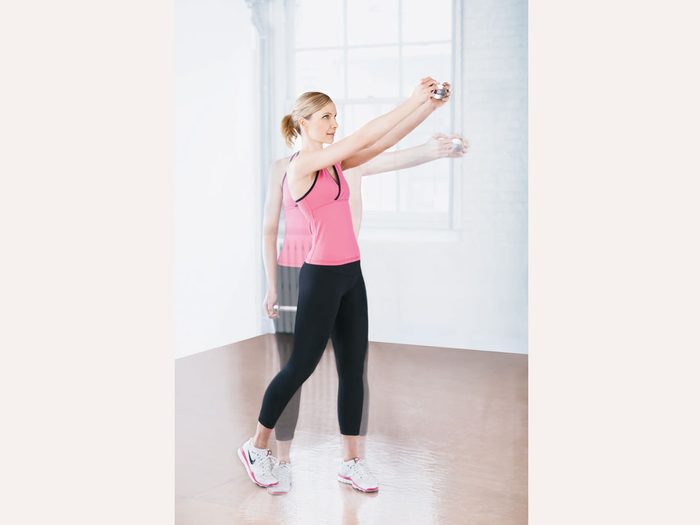
Wood Chops
- Stand with feet hip-width apart, abs tight. With both hands, grip the ends of one medium dumbbell. Place your arms straight down toward the floor with hands and the dumbbell in front of your left hip. Knees should be slightly bent.
- Without arching your back, rotate your torso and pivot onto the ball of your left foot as you turn slightly toward the right. Keep both arms straight while you raise them diagonally across your body from your left hip to overhead on your right side. Hold for two seconds, keeping abs tight.
- Slowly return to starting position. Do five to 10 reps; switch sides.
Bonus: To also work your abs, rotate slowly through your torso as you raise your arms. (Read up on the benefits of working out your core.)
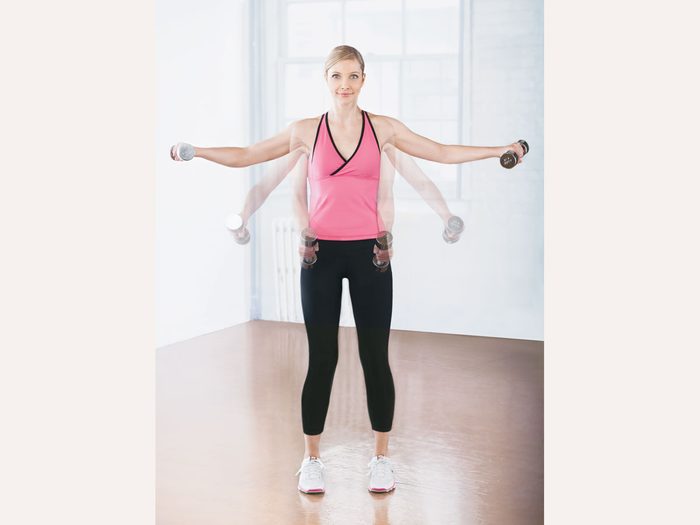
Bent-Arm Side Raise
- With a medium dumbbell in each hand, stand with feet hip-width apart, arms at sides and palms facing inward.
- Bend arms at elbows to about 45 degrees, keeping upper arms close to body. Slowly raise bent arms out to sides until your hands and elbows are below shoulder height.
- Return arms back down to sides. Do eight to 12 reps.
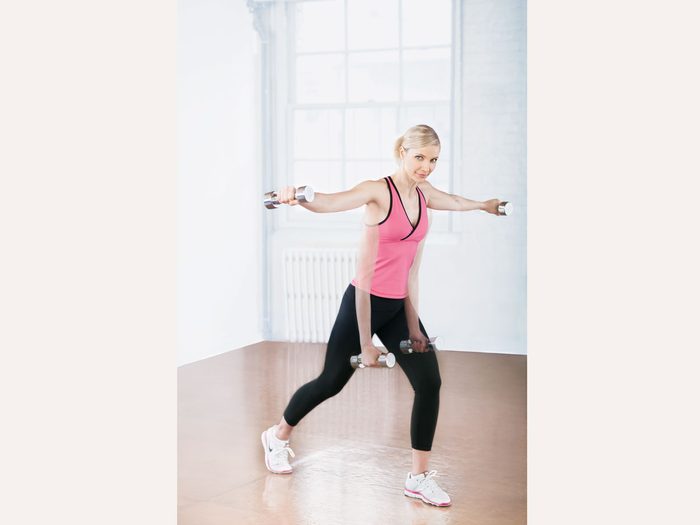
Black Fly
- With a medium dumbbell in each hand, step your right foot forward about two feet. (Next time you do this workout, step forward with your left foot.) Bend your front leg into a semi-lunge and hinge forward slightly from the waist. Keep back straight, abs tight and body weight slightly forward. Roll your shoulders back and down.
- Straighten your arms down toward the floor, hands and dumbbells aligned under shoulders. Slowly raise your arms to the sides, palms down and elbows slightly bent, until hands are just under shoulder height.
- Lower arms back to starting position. Do eight to 12 reps.
Bonus: This is a great posture enhancer as it targets the back of your shoulders. For more shoulder exercises, check out our Better Posture Workout.
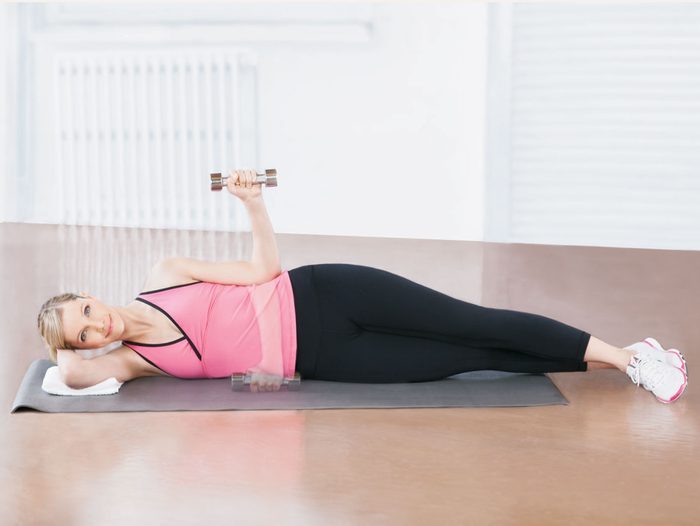
Side-Lying External Rotation
- Lie on a mat on your right side. Place a small folded-up towel under your head and bend your right arm, tucking it between your head and the towel to support your head. Straighten your legs, and cross your left leg over your right one. Hold a light dumbbell (or a can of beans) in your left hand.
- Bend your left arm to 90 degrees, keeping your upper arm and elbow against your side with the dumbbell touching the mat and your palm facing in. Throughout this move, keep your left wrist straight and the elbow touching your side. Rotate your left forearm upward until it points toward the ceiling, your palm facing forward. Keep squeezing the muscles in the back of your left shoulder. Don’t allow your body to roll forward or backward.
- Return to starting position. Do five to 10 reps; switch sides.
Tip: Rotator cuff muscles are often weaker than deltoids, so using a light dumbbell helps ensure proper technique when doing shoulder exercises.
Next, learn the right way to stretch before your next workout.
